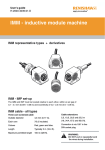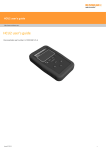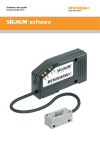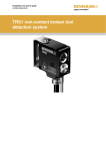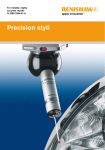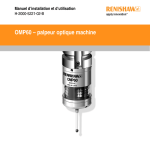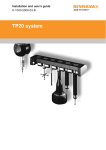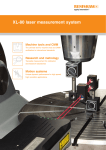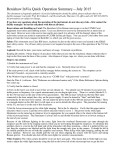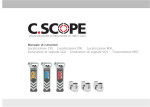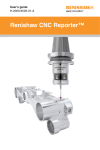Download Installation and user's guide OMI
Transcript
Installation and user’s guide H-2000-5256-05-A OMI-2C optical machine interface English 1 English Installation and user's guide OMI-2C optical machine interface This page is intentionally left blank 1-i © 2005-2014 Renishaw plc. All rights reserved. Disclaimer This document may not be copied or reproduced in whole imply freedom from the patent rights of Renishaw plc. RENISHAW HAS MADE CONSIDERABLE EFFORTS TO ENSURE THE CONTENT OF THIS DOCUMENT IS CORRECT AT THE DATE OF PUBLICATION BUT MAKES NO WARRANTIES OR REPRESENTATIONS REGARDING THE CONTENT. RENISHAW EXCLUDES LIABILITY, HOWSOEVER ARISING, FOR ANY INACCURACIES IN THIS DOCUMENT. Trade marks Warranty RENISHAW and the probe symbol used in the Equipment requiring attention under warranty must be returned to your equipment supplier. or in part, or transferred to any other media or language, by any means, without the prior written permission of Renishaw. The publication of material within this document does not RENISHAW logo are registered trade marks of Renishaw plc in the United Kingdom and other countries. apply innovation and names and designations of other Renishaw products and technologies are trade marks of Renishaw plc or its subsidiaries. All other brand names and product names used in this document are trade names, trade marks, or registered trade marks of their respective owners. Renishaw part no: H-2000-5256-05-A Issued: 07.14 Unless otherwise specifically agreed in writing between you and Renishaw, if you purchased the equipment from a Renishaw company the warranty provisions contained in Renishaw’s CONDITIONS OF SALE apply. You should consult these conditions in order to find out the details of your warranty but in summary the main exclusions from the warranty are if the equipment has been: • neglected, mishandled or inappropriately used; or • modified or altered in any way except with the prior written agreement of Renishaw. If you purchased the equipment from any other supplier, you should contact them to find out what repairs are covered by their warranty. 1-ii CE, FCC statements and WEEE directive c EC declaration of conformity Renishaw plc declares that the OMI-2C optical machine interface complies with the applicable standards and regulations. Contact Renishaw plc at www.renishaw.com/omi-2c for the full EC declaration of conformity. WEEE directive FCC Information to user (FCC Section 15.19) This device complies with Part 15 of the FCC rules. Operation is subject to the following conditions: 1. This device may not cause harmful interference. 2. This device must accept any interference received, including interference that may cause undesired operation. Information to user (FCC Section 15.21) The user is cautioned that any changes or modifications not expressly approved by Renishaw plc or authorised representative could void the user’s authority to operate the equipment. Information to user (FCC Section 15.105) The use of this symbol on Renishaw products and/or accompanying documentation indicates that the product should not be mixed with general household waste upon disposal. It is the responsibility of the end user to dispose of this product at a designated collection point for waste electrical and electronic equipment (WEEE) to enable reuse or recycling. Correct disposal of this product will help to save valuable resources and prevent potential negative effects on the environment. For more information, please contact your local waste disposal service or Renishaw distributor. This equipment has been tested and found to comply with the limits for a Class A digital device, pursuant to part 15 of the FCC Rules. These limits are designed to provide reasonable protection against harmful interference when the equipment is operated in a commercial environment. This equipment generates, uses and can radiate radio frequency energy and, if not installed and used in accordance with this installation guide, may cause harmful interference to radio communications. Operation of this equipment in a residential area is likely to cause harmful interference, in which case you will be required to correct the interference at your own expense. Patent and safety notices Patent notice Features of OMI-2C optical machine interface, and other related products, are the subject of one or more of the following patents and/or patent applications: EP 0974208 US 6839563 EP 1503524 JP 429401 Information for the user There are no user serviceable parts inside the OMI-2C. Return defective units to an authorised Renishaw Customer Service Centre. Please quote the serial number. Remove power before performing any maintenance operations. CNC machine tools must only be operated by competent persons in accordance with the machine supplier’s operating instructions. 1-iii Information for the machine’s supplier It is the responsibility of the machine’s supplier to ensure that the user is made aware of any hazards involved in operation, including those mentioned in Renishaw product documentation, and to ensure that adequate guards and safety interlocks are provided. 1-iv Preliminary information Environment IP rating The front face of the OMI-2C is sealed to IPX8 (when the unit is correctly installed). Temperature Storage: The OMI-2C should be stored in an area where the ambient temperature will remain between –10 °C and 70 °C (14 °F to 158 °F). Operation: The OMI-2C may be operated in ambient temperatures of between 0 °C and 60 °C (32 °F and 140 °F). Specification Weight of unit with retaining bracket: 70 g (2.5 oz) Care of the equipment The OMI-2C should be kept clean from dirt, coolant and machining debris at all times, otherwise the transmission range may be reduced. Wipe the window clean as often as is necessary to maintain unrestricted transmission. When handling, treat the OMI-2C with care. It is a precision component that can be easily damaged. Do not apply labels to, or otherwise obstruct, the window of the OMI-2C. Contents 1-1 Contents System overview . . . . . . . . . . . . . . 1-2 OMI-2C electrical outputs and inputs . . . 1-10 Typical system . . . . . . . . . . . . . . . . 1-3 OMI-2C visual diagnostics . . . . . . . . . 1-11 System performance . . . . . . . . . . . . 1-4 OMI-2C output waveforms . . . . . . . . . 1-12 Performance envelope of OMP60 and OMI-2C . . . . . . . . . . . . . . . . . . . 1-5 Fault finding . . . . . . . . . . . . . . . . 1-13 Mounting the OMI-2C . . . . . . . . . . . . 1-6 OMI-2C dimensions and cable connection . 1-7 OMI-2C cable recommendation and electrical connection . . . . . . . . . . . . . 1-8 OMI-2C wiring diagram . . . . . . . . . . . 1-9 Parts list . . . . . . . . . . . . . . . . . . 1-17 1-2 System overview System overview The OMI-2C provides an interface between the machine controller and Renishaw’s range of modulated transmission probes, such as the OMP60. The OMI-2C converts optical signals into electrical signals suitable for use by the machine controller. The OMI-2C converts electrical signals from the controller into modulated optical probe signals. This facility allows the machine controller to be used to optically switch the probe on and off. When in operation, the OMI-2C will report the following probe conditions via a multi-colour LED: • Probe status • Error • Low battery Typical system – OMP60 probe with OMI-2C CNC machining centre spindle 1-3 Cable CNC machine control OMI-2C (optical machine interface) OMP60 probe Serial No. V68739 Stylus Workpiece 1-4 System performance System performance Operating envelope Reflective surfaces within the machine cabinet may increase the signal transmission range. Coolant residue accumulating on the windows of the OMI-2C and OMP will have a detrimental effect on transmission performance. Wipe the windows clean as often as is necessary to maintain unrestricted transmission. For best system performance, ensure that the OMI-2C is mounted in a position which is not directly in front of a light source. ! CAUTION: If two systems are operating in close proximity, take care to ensure that signals transmitted from the OMP on one machine are not received by the OMI-2C on the other machine and vice versa. Performance envelope of OMP60 probe and OMI-2C Performance envelope of OMP60 probe and OMI-2C 1-5 Switch on/off Operating – standard power mode Operating – low power mode OMP60 probe and OMI-2C 360° transmission around probe axis in metres (feet) The probe and OMI-2C diodes must be in each other’s field of view, and within the performance envelope shown. The OMP60 is fully described in the OMP60 installation guide H-4038-8505. 1 (3.3) 2 (6.5) 3 (9.8) 4 (13.1) 5 (16.4) 6 (19.9) 7 (23.0) 8 (26.2) 9 (29.5) 75° OMI-2C 60° 45° OMP60 15° 0° 1 (3.3) 2 (6.5) 3 (9.8) 4 (13.1) 5 (16.4) 6 (19.9) 7 (23.0) 8 (26.2) 9 (29.5) 15° 30° 45° 75° 60° 75° 75° 30° 60° 60° 45° 45° 30° 30° 15° 15° Optical centre line 0° Typical plot at 20 °C (68 °F). Dotted line represents operating range with OMP60 low optical power. Range m (feet) 1-6 Mounting the OMI-2C Mounting the OMI-2C ! WARNING: Ensure the machine tool is in a safe condition and power is removed before removing covers. Only qualified persons should adjust switches. ! CAUTION: Different versions of the OMI‑2C operate with specific machine controllers. Prior to installation, ensure that the OMI-2C is compatible with the machine controller. The OMI-2C should be mounted as near to the machine spindle as possible (as shown in the system diagram on page 1-3). To achieve the best possible transmission range and performance envelope, it is recommended that the mounting screw is positioned on the far side of the OMI-2C, relative to the expected probe position. When mounting the OMI-2C, it is important that the sealing ring forms a tight seal around the rim of the bore into which the body of the OMI-2C is to be located. ! CAUTION: Make sure that the sealing ring is lubricated prior to being mounted in the machine spindle. OMI-2C dimensions and cable connection 1-7 OMI-2C dimensions and cable connection Ø17.1 (0.67) 111.5 (4.39) 29 (1.14) 11 (0.43) 22 (0.87) Socket head capscrew M4 × 12 14 (0.55) View A Ø17.7 (0.697) Ø17.6 (0.693) 8 (0.31) 6.75 (0.27) Ra 1.6 (64) Installation detail Ø20 (0.79) Ø18.7 (0.74) 30° 15° Bore diameter Ø18.02 (0.709) Ø18.00 (0.708) 2.8 (0.11) MAX 6 (0.24) minimum depth View A dimensions mm (in) Binder connector (Series 712) 09-0427-80-08 Pin Function 1 2 3 4 5 6 7 8 0V 15 V – 30 V Start Probe status Error Low battery Screen Not used 1-8 OMI-2C cable recommendation and electrical connection Cable recommendation OMI-2C electrical connection Cables must be routed carefully to avoid potential sources of electromagnetic interference. OMI-2C power supply Cable specification Ø4.5 mm (0.18 in) to Ø5.0 mm (0.20 in), 12 core screened cable each core 7/0.1 mm. Standard cable variants The OMI-2C standard polyurethane cables are 8 m (25 ft) and 15 m (49 ft) long. NOTE: Maximum length of the specified cable must not exceed 30 m (98 ft). The OMI-2C requires a suitably fused (500 mA) 24 volt clean power supply, which is capable of providing up to 200 mA of current. The supply can be taken from the machine, or via an external power supply. It is important that any input voltage ripple will not cause the voltage to fall below 15 volts or rise above 30 volts. Connection of the OMI-2C to the power supply is achieved via the 8 pin connector located on the rear of the OMI-2C. If a Renishaw cable is supplied then the colours shown in the diagram opposite can be used. OMI-2C wiring diagram 1-9 OMI-2C wiring diagram Driver Pin 4 (turquoise) Probe status (20 mA maximum) Driver Pin 6 (violet) Low battery (20 mA maximum) Driver Pin 5 (green) Error (20 mA maximum) Pin 3 (white) Start input 0V 0V 0V Buffer (15 V to 30 V, 19 mA@30 V) 15 V to 30 V Pin 2 (red) 0 V Pin 1 (black) Screen Power supply (15 V to 30 V) (200 mA maximum) Pin 7 (grey) Machine ground (star point) ! CAUTION: The power supply 0 V should be terminated at the machine ground (star point). 1-10 OMI-2C electrical outputs and inputs OMI-2C outputs The OMI-2C has three electrical outputs which are driven relative to the ground connection: Probe status (pin 4) Error (pin 5) Low battery (pin 6) The maximum rated sink or source current per output is 20 mA. If this current is exceeded, the OMI-2C isolates all outputs and the visual diagnostics LED will flash red. When an 8 m Renishaw cable assembly is used and outputs are driven high, they may be up to 2 V below the supply voltage. Alternatively, when the outputs are driven low, they may be up to 2 V above 0 V. When a 15 m Renishaw cable assembly is used and outputs are driven high, they may be up to 2.5 V below the supply voltage. Alternatively, when the outputs are driven low, they may be up to 2.5 V above 0 V. NOTE: Refer to parts list for Renishaw OMI-2C cable assemblies. The OMI-2C will respond to a received probe trigger signal with a delay of 500 µs ±15 µs. The time delay from the physical probe trigger to any output change will depend on the configuration of the probe. OMI-2C input The OMI-2C has a single electrical input that allows the machine controller to switch the probe on and off. The start input (pin 3) must be connected to the machine’s start and stop M-code. When the input is active (15 V to 30 V, 19 mA@30 V), the probe is switched on. OMI-2C visual diagnostics 1-11 OMI-2C visual diagnostics When in operation, the OMI-2C displays its present status via a multicoloured LED located behind the front window. The LED display configuration is as shown below. LED Probe status Flashing green (for 3 seconds on power up) Controller type: Heidenhain i530/ Siemens 840D Constant red Probe on and triggered Constant green Probe on and seated Constant blue Probe error or probe off Flashing blue and red Low battery when probe is triggered Flashing blue and green Low battery when probe is seated Yellow flash (0.5 second duration) Start/stop signal Flashing red Overcurrent condition (reset OMI-2C by removing power) Graphic hint 1-12 OMI-2C output waveforms OMI-2C output waveforms PROBE Triggered Seated OMI-2C OUTPUTS Probe switch on Power off Probe status Seated Probe reseat Error e.g. Low signal Error clear Low battery Output high Trigger low Output low Error Output high Normally high Output low Low battery Output high Normally high Probe trigger Output low The ouput signals from the OMI-2C must be compatible with the machine control input. Probe switch off Fault finding 1-13 Fault finding If in doubt, consult your probe supplier. Symptom Cause Action No LED display when power is on. No power supply. Ensure that the power source has not been isolated from the main electrical supply. Cable used to connect the OMI-2C to the power supply has been damaged, is of incorrect specification or has been incorrectly wired. Visually inspect the cable for obvious signs of damage. Test the cable to ensure the electrical continuity of each wire. Verify that the cable has been correctly wired for use with the OMI-2C. Rear pin connector on OMI‑2C is loose or disengaged. Ensure rear pin connector is properly engaged and secure. Pins on electrical connector damaged or missing. Visually inspect the connector to ensure that no pins are damaged or missing. OMI-2C unit is itself defective. Contact your supplier for assistance. 1-14 Fault finding Symptom Cause Action OMI-2C LED continuously flashes red. Output signal has required too high a current. Confirm that the outputs from the OMI-2C are correctly wired into the inputs of the machine controller. Reset the OMI-2C by first removing and then reapplying the power supply to the unit. Disconnect all output wires and ensure that none have been connected to a power signal supply. Probe fails to switch Installation/CNC program on when in ‘optical fault. start’ mode or switch Beam obstructed. off when in ‘optical stop’ mode. Incompatible probe/probe transmission setting. Correct M-code wiring and/or CNC program. Clean the OMI-2C window and remove any obstructions. Change probe or probe setting to ‘modulated’. Dead probe batteries. Replace probe batteries. Optical interference is blocking the start signal. Remove source of interference. Fault finding 1-15 Symptom Cause Action Probe stops in mid-cycle. Beam obstructed. Remove obstruction. Optical interference. Remove source of interference. Intermittent wiring fault. Correct wiring. Probe is in ‘timer off’ mode and has not been triggered for the timer period. Increase ‘timer off’ time setting or change probing routine. Probe has not been triggered for more than 90 minutes. Re-start probe and ensure that the probe is not idle for 90 minutes. Interfering light source shining directly into OMI-2C window. Remove source of interference. A signal is being received from a probe on an adjacent machine. Change the adjacent probe to low power mode. Installation/CNC program fault. Check error output and CNC program. or An unexpected error occurs during a probing cycle. or An unexpected trigger occurs during the probing cycle. Probe switches on, but OMI-2C error remains active. 1-16 Fault finding Symptom Cause Action Probe indicates ‘low battery’ condition, but the machine control does not. Installation/CNC programming fault. Check ‘low battery’ output wiring and/or CNC program. Machine control does not respond to the probe being triggered or seated. Probe is not switched on. Attempt to switch it on. Installation/CNC program fault. Correct ‘probe status’ output wiring and CNC program. A signal is being received from a probe on an adjacent machine tool. Change the adjacent probe to ‘low power mode’. Probe fails to switch on. Probe was already on when the start signal was transmitted. Check that the probe was turned off at the end of the last probing cycle. Parts list 1-17 Parts list Please quote the part number when ordering equipment. Type Part number Description OMI-2C kit A-5314-0001 OMI-2C kit that is compatible with Heidenhain i530 or Siemens 840D controllers. Kit includes: OMI-2C, mounting kit, toolkit and user’s guide. Cable (8 m) A-5314-0015 OMI-2C cable assembly, including 8 metres of cable. Cable (15 m) A-5314-0016 OMI-2C cable assembly, including 15 metres of cable. This page is intentionally left blank. Renishaw plc New Mills, Wotton-under-Edge, Gloucestershire, GL12 8JR United Kingdom T +44 (0)1453 524524 F +44 (0)1453 524901 E [email protected] www.renishaw.com For worldwide contact details, please visit our main web site at www.renishaw.com/contact *H-2000-5256-05*





























